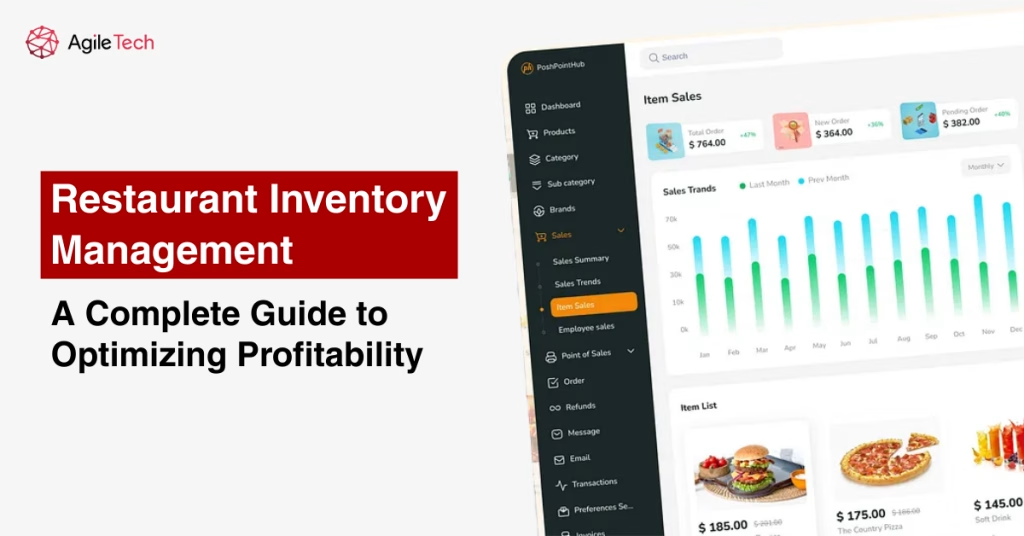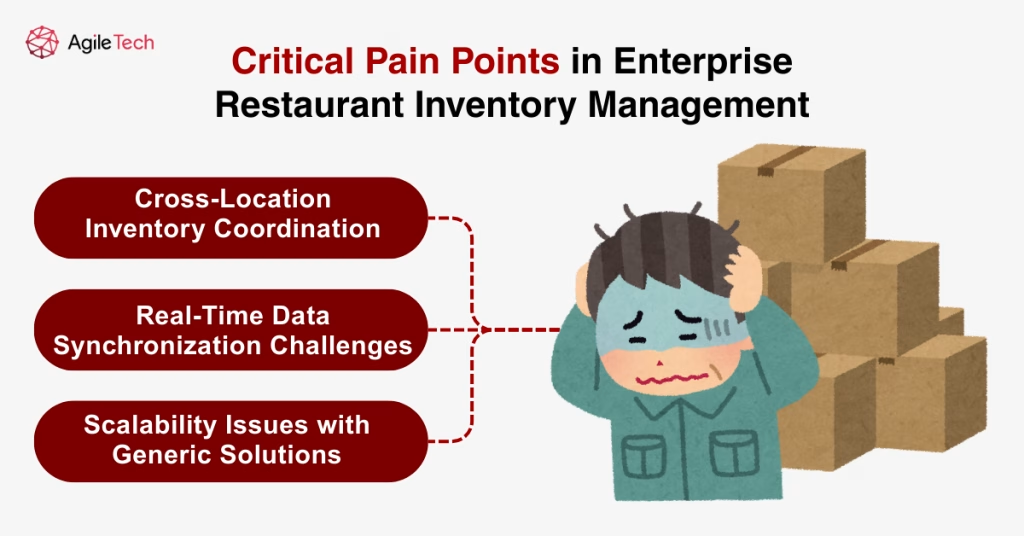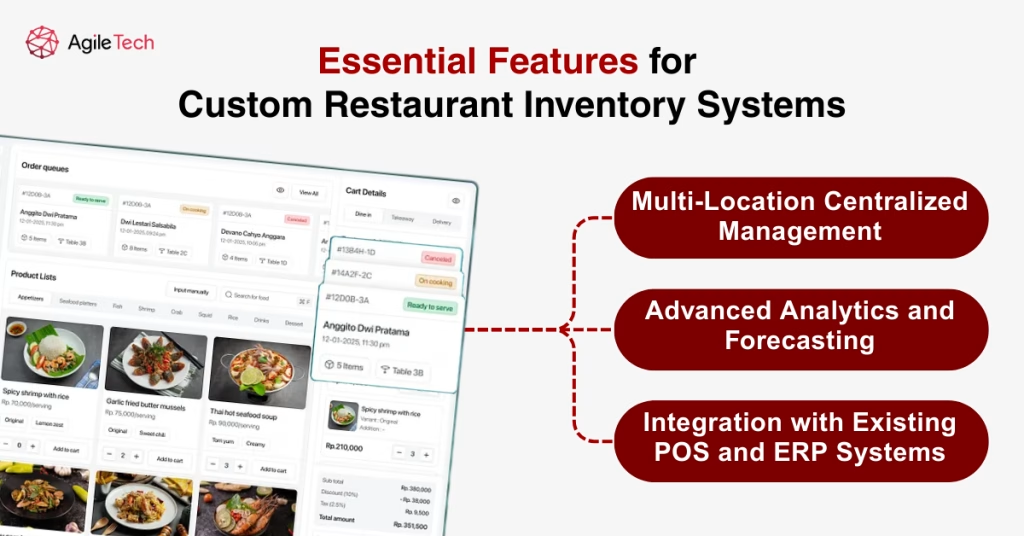Restaurant Inventory Management: A Complete Guide to Optimizing Profitability
The restaurant industry continues to face unprecedented challenges in 2025, with restaurant inventory management emerging as a critical factor that can make or break profitability. The United States restaurant and foodservice market is projected to reach $1.6 trillion by the end of 2025, yet 75% of large restaurant chains struggle to maintain consistent profit margins due to inadequate inventory control systems. For enterprise-level restaurant operations managing dozens or hundreds of locations, the complexity of coordinating inventory across multiple sites while maintaining cost efficiency has become a strategic imperative that demands customized solutions rather than generic software packages.

- 1. Why Large Restaurant Chains Need Custom Inventory Management Solutions
- 2. Critical Pain Points in Enterprise Restaurant Inventory Management
- 3. Essential Features for Custom Restaurant Inventory Systems
- 4. Technical Architecture for Restaurant Inventory Solutions
- 5. AgileTech – Your Custom Inventory Management Developer
- Conclusion
1. Why Large Restaurant Chains Need Custom Inventory Management Solutions
1.1. Restaurant Inventory Management Explained
For large restaurant chains with dozens or hundreds of locations, inventory management involves much more than tracking stock. It requires real-time coordination across procurement, storage, prep, and service to control costs and maintain brand consistency. Modern systems integrate with POS, supplier networks, and finance tools to provide visibility into inventory levels and cost trends. Weekly inventory tracking can boost profits by 2%–10%, and achieving an inventory turnover ratio of 4–8 times per month is key, especially given the perishable nature of food.
1.2. Limitations of Off-the-Shelf Software Solutions
Off-the-shelf inventory systems often fall short for enterprise-level chains. While suitable for single-location restaurants, they lack the scalability, flexibility, and integration required for complex multi-site operations. These solutions can’t adapt to proprietary recipes, custom workflows, or unique supplier relationships. As a result, businesses either compromise efficiency or rely on costly workarounds. Limited customization also means restaurants must adjust to the software, instead of having a solution tailored to their needs.
1.3. Why Choose Custom Development Over Standard Solutions
Custom restaurant inventory management system development provides enterprise restaurant chains with the strategic advantage of technology that adapts to your business model, not the other way around. Unlike purchasing pre-built restaurant inventory software, custom development ensures that every feature, integration, and workflow is designed specifically for your operational requirements, brand standards, and growth objectives.
The competitive advantage of custom development extends beyond basic functionality. Your custom system can incorporate proprietary algorithms for demand forecasting based on your specific market data, integrate seamlessly with your existing POS infrastructure, and provide executive-level analytics tailored to your KPIs. When you’re managing hundreds of locations with millions in inventory value, the ROI of custom development typically exceeds off-the-shelf solutions within the first year of implementation.
Custom solutions also enable restaurant chains to implement advanced features like predictive analytics for demand forecasting, automated supplier price comparisons, and integration with third-party logistics providers. These capabilities can significantly reduce manual labor, minimize human error, and provide the real-time visibility needed to make informed business decisions.
1.4. The Impact of Inventory on Restaurant Profitability
Food inventory management directly impacts restaurant profitability through multiple channels. Poor inventory control leads to excessive food waste, which represents a significant cost burden for restaurants. US restaurants waste about 4-10% of the food they purchase, translating to millions of dollars in lost revenue annually. If a restaurant with a $1 million annual food budget loses $40,000 to $100,000 before the food leaves the kitchen, that’s a huge inefficiency.
Beyond waste reduction, effective restaurant inventory management enables restaurants to optimize their food cost percentage, which is a critical metric for profitability. Reducing food inventory levels by two or three days can reduce your food cost by approximately 2 to 3% or more, demonstrating the immediate financial impact of implementing restaurant inventory management best practices.
For enterprise restaurant chains managing 50-1,000+ locations, the financial impact of optimized inventory management extends far beyond simple waste reduction. Poor inventory control across multiple locations can result in millions of dollars in lost revenue through excess carrying costs, spoilage, and stockouts. When you’re processing thousands of SKUs across hundreds of locations, even a 1% improvement in inventory efficiency can translate to significant profit gains.
Read more: What Is Inventory Management Software and Why Do Businesses Need It?
2. Critical Pain Points in Enterprise Restaurant Inventory Management

2.1. Cross-Location Inventory Coordination
Managing inventory across dozens or hundreds of locations is one of the toughest challenges for restaurant chains. Each site faces unique local demand, yet corporate requires unified cost control and reporting. Without centralized yet flexible systems, chains struggle during seasonal shifts or promotions, leading to overstock or stockouts that hurt profits and customer satisfaction. Supplier contracts also vary by region, making coordination even more complex without custom multi-location inventory software.
2.2. Real-Time Data Synchronization Challenges
Effective restaurant inventory control depends on real-time data from POS, deliveries, kitchens, and management systems. However, many chains suffer from disconnected systems, leading to delays, inaccuracies, and poor decisions. Without real-time sync, inventory mismatches can cause losses. Technical issues like downtime or failed integrations worsen the problem, making robust infrastructure critical. With the restaurant software market set to grow rapidly, investment in integrated systems is essential.
2.3. Scalability Issues with Generic Solutions
As restaurant chains grow, generic inventory software often fails to keep up. These systems struggle with large transaction volumes and real-time reporting across multiple sites, leading to slowdowns and inefficiencies. They also lack flexibility to adapt to new markets or business models. Without scalable architecture, chains may resort to multiple tools or compromise processes, both of which reduce operational efficiency and profit margins.
3. Essential Features for Custom Restaurant Inventory Systems

3.1. Multi-Location Centralized Management
Enterprise restaurant chains require custom restaurant inventory management systems that provide seamless integration between corporate oversight and location-specific operations. Your system must enable corporate executives to monitor inventory performance across all locations while providing local managers with the tools they need for day-to-day operations. This dual-layer architecture ensures that you maintain brand consistency and cost control while empowering local teams to optimize their specific market conditions.
Centralized management features should include consolidated reporting across all locations, automated alerts for unusual inventory variances, and standardized processes for receiving, storage, and preparation. The system must also support location-specific customization for menu items, supplier relationships, and operational procedures while maintaining consistency in core restaurant inventory management best practices.
Advanced centralized systems incorporate machine learning algorithms to identify patterns across locations and recommend optimization strategies. These systems can analyze consumption patterns, seasonal trends, and supplier performance to provide actionable insights for inventory optimization. Integration with corporate financial systems enables seamless cost accounting and profitability analysis across the entire chain.
3.2. Advanced Analytics and Forecasting
Your custom restaurant inventory management system must incorporate sophisticated analytics capabilities that go beyond basic reporting to provide predictive insights that drive strategic decision-making. For enterprise restaurant chains managing complex operations across multiple markets, advanced analytics can identify opportunities for cost reduction, demand optimization, and operational efficiency improvements that generic restaurant inventory software simply cannot deliver.
Forecasting algorithms should consider historical sales data, weather patterns, local events, and promotional activities to generate accurate demand predictions. The system must be capable of adjusting forecasts in real-time based on actual sales performance and external factors. This dynamic forecasting capability is essential for maintaining optimal inventory levels while minimizing carrying costs and waste, representing a core component of restaurant inventory management best practices.
Advanced analytics features should include variance analysis, trend identification, and performance benchmarking across locations. The system must provide intuitive dashboards and reporting tools that enable managers to quickly identify issues and opportunities. Integration with business intelligence tools allows for deeper analysis and strategic planning based on inventory performance data.
3.3. Integration with Existing POS and ERP Systems
Seamless integration with existing restaurant technology infrastructure is crucial for custom restaurant inventory management systems. The system must connect with POS systems to track real-time sales data, ERP systems for financial reporting, and supplier portals for automated ordering. This integration eliminates data silos and ensures consistent information across all operational systems.
Integration capabilities should extend to recipe management systems, enabling accurate cost calculations based on current ingredient prices and consumption patterns. The system must also connect with scheduling systems to optimize labor allocation based on inventory receiving and preparation requirements. Mobile integration enables field managers to access inventory information and perform tasks remotely, supporting efficient food inventory management workflows.
API-based integration architecture provides flexibility for connecting with various third-party systems and future technology additions. The system should support both real-time and batch integration modes to accommodate different operational requirements. Robust error handling and data validation ensure integration reliability and data integrity across all connected systems.
Read more: Top 9 Inventory Management Software Features Every Business Should Know
4. Technical Architecture for Restaurant Inventory Solutions

4.1. Cloud-Based vs. On-Premise Deployment
For enterprise restaurant chains, the decision between cloud-based and on-premise deployment of your custom restaurant inventory management system depends on your specific operational requirements, security policies, and IT infrastructure. Cloud deployment offers scalability advantages for rapidly growing chains, with the ability to add new locations without significant hardware investments. However, some large restaurant chains prefer on-premise solutions for greater control over sensitive operational data and integration with existing enterprise systems.
Cloud deployment enables real-time data synchronization across all locations, providing corporate management with immediate visibility into inventory levels and performance metrics. The scalability of cloud infrastructure accommodates business growth without requiring significant hardware investments. Additionally, cloud-based systems offer superior disaster recovery capabilities and geographic redundancy, ensuring business continuity even during system failures.
However, some restaurant chains may prefer on-premise deployment for specific requirements such as data sovereignty, customization needs, or integration with legacy systems. Hybrid approaches combining cloud and on-premise elements can provide the benefits of both deployment models while addressing specific business requirements. The decision should be based on factors including budget, technical expertise, security requirements, and long-term business strategy.
Read more: Inventory Management Software Cost in 2025: What You Should Know
4.2. API Integration and Third-Party Connectivity
Modern inventory management systems must provide comprehensive API capabilities to enable seamless integration with the diverse technology ecosystem used by restaurant chains. RESTful APIs facilitate real-time data exchange with POS systems, supplier portals, financial systems, and third-party logistics providers. These integrations eliminate manual data entry, reduce errors, and provide a unified view of inventory operations.
API architecture should support both inbound and outbound data flows, enabling the inventory system to consume data from external sources while providing information to other systems. Rate limiting, authentication, and security protocols ensure safe and reliable API operations. Webhook support enables real-time notifications and triggers for automated processes based on inventory events.
Third-party connectivity extends to supplier catalogs, pricing systems, and delivery tracking services. The system should support multiple data formats and communication protocols to accommodate various supplier systems. EDI integration capabilities enable automated purchase order processing and invoice reconciliation with major suppliers, reducing administrative overhead and improving accuracy.
4.3. Mobile Applications for Field Management
Push notifications through mobile apps enable real-time alerts for critical inventory events such as low stock levels, expired products, or delivery delays. The mobile application should synchronize data seamlessly with the central system, ensuring that all inventory transactions are recorded accurately and immediately. Role-based access controls ensure that users can only access appropriate functionality based on their responsibilities.
5. AgileTech – Your Custom Inventory Management Developer
As a leading provider of custom restaurant inventory management solutions, AgileTech specializes in developing enterprise-grade systems for large restaurant chains managing 50-1,000+ locations. Our development team combines deep restaurant industry expertise with cutting-edge technology to create solutions that address the unique challenges of multi-location operations while providing the scalability and flexibility that growing restaurant chains demand.
Our custom development approach begins with a comprehensive analysis of your existing operations, supply chain relationships, and growth objectives. We don’t sell pre-built restaurant inventory software; instead, we create fully customized systems that integrate seamlessly with your existing POS infrastructure, supplier networks, and financial reporting systems. This ensures that your investment in technology supports your established business processes rather than forcing operational changes.
AgileTech’s custom development methodology emphasizes scalability and flexibility, ensuring that your restaurant inventory management system can grow with your business expansion plans. Whether you’re managing 50 locations today with plans to reach 500, or operating 1,000+ locations with complex multi-regional supply chains, our systems are architected to handle enterprise-level complexity while maintaining optimal performance.
Our development team provides comprehensive project management, from initial requirements gathering through deployment and ongoing support. We understand that implementing new restaurant inventory software across multiple locations requires careful planning and execution to minimize operational disruption. That’s why we offer phased implementation approaches that allow you to validate system performance before full-scale deployment across your entire restaurant chain. This service-oriented approach ensures that your investment in custom development delivers measurable ROI while supporting your long-term business objectives.
Conclusion
For large restaurant chains managing complex multi-location operations, custom restaurant inventory management systems represent a strategic investment that directly impacts profitability, operational efficiency, and competitive advantage. While generic restaurant inventory software may seem cost-effective initially, the limitations become apparent as your business scales, often resulting in operational inefficiencies that far exceed the initial cost savings.
The decision to invest in custom development rather than purchasing off-the-shelf restaurant inventory software is ultimately about maximizing your business potential. Custom systems provide the flexibility to implement proprietary business processes, integrate with existing infrastructure, and scale with your growth objectives. With restaurants spending approximately $162 billion annually on waste-related costs, the ROI of optimized inventory management for restaurants is substantial and measurable.
AgileTech’s custom development approach ensures that your restaurant inventory management system becomes a strategic asset that supports your business objectives rather than a technology constraint that forces operational compromises. For enterprise restaurant chains ready to optimize their inventory operations and drive sustainable profitability, custom development provides the foundation for long-term success in an increasingly competitive market.